#implicit bias
Text

I just think we should start framing these things in the first person. I am not immune to propaganda. I have implicit biases, in spite of my explicit beliefs, which I need to keep in check.
#guiltyedits#you are not immune to propaganda#garfield#I have a bunch of stray reasons for this argument but they're not coherent right now <3 I'm sure nobody's DYING trying to figure it out lmao#implicit bias#internalized#affirmations#self-regulation#leftist
93 notes
·
View notes
Text
The Curse finale interpretation
Ash's ascent/death, parallels to pregnancy, and "lived experience" in The Curse
There was a parallel between the way nobody believed or understood Asher when he was stuck in the tree to the way that pregnant people are treated while they are in labor (or even how women are treated in medical settings in general)
Ash's ascent/death
Nobody would believe Ash (besides Whitney who witnessed him floating inside the house and Moses who saw Ash float up into the tree) that he couldn't come down. Everyone who sees him projects their own interpretation of Ash's experience and intentions.
Dougie thinks Ash is running from his responsibilities because Dougie's dad did the same, and (from Dougie's POV), some men panic or even run away from their responsibilities once their partner is in labor or gives birth.
The neighbors from the community think that Ash and Dougie must be filming something because that's is their experience with these outsiders; they are TV people and act strangely, which can be explained by assuming that any weird behavior is a part of making a TV show. This explanation is also the best that they have for how Ash could possibly defy physical law (because it really isn't reasonable to assume that he just is breaking physical law in some way).
Ash repeatedly tells them that he will fly up. He tries his best to explain what he is going through, and he isn't doing the best job, probably because he's extremely afraid that he might die. I repeatedly tells Dougie and the first responders what he needs from them, and nobody listens. They think that Ash is delusional and that everyone else has a better understanding of the situation and therefore know what to do.
Connection to pregnancy
I think some of Ash's experience can be seen as analogous to what pregnant women (and women in medical settings in general) experience. Historically, doctors have been male, and they obviously have never been pregnant or gone into labor, and studies show that even women healthcare providers dismiss women and minorities in medical settings (it has to do with socialized biases in everyone, which I will come back to).
These professionals often dismiss a pregnant person's self-report of needing help, and a CDC report shows that 1 in 5 women report medical mistreatment while giving birth:
Approximately one in five (20.4%) respondents reported experiencing at least one type of mistreatment. The most commonly reported experiences of mistreatment were being ignored by health care providers, having requests for help refused, or not responded to (9.7%); being shouted at or scolded by health care providers (6.7%); having their physical privacy violated (5.1%); and being threatened with withholding of treatment or being forced to accept treatment they did not want (4.6%).
The same report found that the poorer the woman or more marginalized her background, the more risk of facing mistreatment:
Overall, 28.9% of respondents reported experiencing at least one form of discrimination during maternity care (Table 3), with highest prevalences reported by Black (40.1%), multiracial (39.4%), and Hispanic (36.6%) respondents. Overall, the most commonly reported reasons for discrimination were age (10.1%), weight (9.7%), and income (6.5%); reasons varied by race and ethnicity.
Initially Whitney planned to go to what was implied to be a better hospital. It feels like the show maybe wanted the viewer to expect that Whitney would die due to being at a "poor" hospital (and maybe she did; the finale went no full magical realism, imo). Benny and Nathan probably expected that viewers would immediately think or even assume that this would happen (drawing from our own biases, even if they are informed by statistics), which makes me think that Ash's experience is analogous to pregnant peoples' medical mistreatment.
In these medical settings, doctors frequently ignore a pregnant person's self-reports or requests for help, and instead, the doctors and medical staff (regardless of gender) tend to think that they know better or that the pregnant person is delusional/hormonal/emotional/etc. They dismiss their lived experience. Doctors have historically been male, so they have NO experience being pregnant, but they think they know better than the pregnant person, and even women who have been pregnant cannot speak for every woman. It is not rational to take your own experiences and extrapolate them to everyone else (which has been a common theme in the show: making assumptions based off of limited experience or socialized biases).
Like pregnant people facing medical mistreatment, Ash was ignored by health care providers Dougie and First Responders, had requests for help refused, or not responded to; he was shouted at or scolded by health care providers Dougie for running from responsibilities of becoming a father; and had treatment withheld (the anchored net that he repeatedly begged for) and was forced to accept treatment they did not want (tree branch cut off, sending him to his death).
Lived experience, hermeneutical gaps, and epistemic injustice
OKAY. So this comes back to (what I have taken to be) the overall recurrent theme of The Curse: lived experience, hermeneutical gaps/injustice, and testimonial injustice (which are forms of epistemic injustice, for anyone who is interested in learning more about this).
Hermeneutical gaps occur when a person or group lacks the concepts or terminology to describe their experience. Such gaps lead to hermeneutical injustice; Miranda Fricker describes hermeneutical injustice as occurring
when a gap in collective interpretive resources puts someone at an unfair disadvantage when it comes to making sense of their social experiences. An example of the first might be that the police do not believe you because you are black; an example of the second might be that you suffer sexual harassment in a culture that still lacks that critical concept . . . hermeneutical injustice is caused by structural prejudice in the economy of collective hermeneutical resources.
Before the term 'sexual harassment' came to be, people impacted by such harassment didn't have the concepts or terminology to be able to describe their experience or what they were going through; they were often dismissed as just being flirted with or they didn't even discuss their experience because even though the felt like something was wrong, they didn't have the concepts to articulate their experience, particularly to groups who do not have such experiences.
Here, Fricker describes hermeneutical injustice as:
. . . someone has a significant area of their social experience obscured from understanding owing to prejudicial flaws in shared resources for social interpretation . . . The wrong is analysed in terms of a situated hermeneutical inequality: the prejudicial flaws in shared interpretive resources prevent the subject from making sense of an experience which it is strongly in her interests to render intelligible.
So hermeneutical gaps (lack of conceptual resources [words or formed concepts] to describe experience) lead to hermeneutical injustice (where a person's experience is misinterpreted in a way that leads to harm or testimonial injustice).
Testimonial injustice occurs when one party (person or group) dismisses the credibility of another group (basically treating the marginalized person as though they are not a true knower).
An example might be Fernando trying to be heard about his knowledge of the community violence. Whitney dismisses him, thinking that she knows more about systemic issues. Ash takes advantage of this kind of injustice when he tries to cover his lie that Abshir, Nala, and Hani live in transitional housing once they bought the property they live in. Whitney called out the inconsistency, and Ash decided to exploit the lack of credibility marginalized people are usually extended. He says something like "honestly I don't know with them they say one thing then another," implying that they are dishonest.
Connecting Ash's ascent/death and medical mistreatment of pregnant people with overall themes in The Curse
ANYWAY. Pregnant people in labor go through a unique experience, and sometimes they lack the concepts necessary to explain their experience in a way that medical professionals will "understand" or take seriously (hermeneutical gap leading to hermeneutical injustice). Further, medical professionals dismiss a pregnant person's testimony and treat them like they are not credible while the medical professionals work from their own assumptions or formal medical knowledge (testimonial injustice).
Asher does not have the concepts to describe what he's going through. Nobody has experienced what he experienced, and the experience is new to him, so he doesn't know how to convey what he experiences in a way that Dougie and First Responders will understand. Further, Dougie and the First Responders dismiss Ash's testimony and treats him like he's not credible while Dougie and the First Responders work from their own assumptions or ascriptions of Ash's intentions.
Throughout the show, our main characters have made assumptions about poor people, natives, and their own employees. Many of these assumptions arise out of dismissing or discrediting the experiences of others in favor of their own interpretation of events or others' intentions. Whitney (and Ash) thinks she knows what's best for Las Espanola, even though she lacks the lived experience or even the proper educational experience to understand the complex nature of amending systemic injustice. She is like the medical professionals and First Responders who do not listen to the lived experiences (self-reports) of what people want or need.
This behavior necessarily implies that the people she's helping don't know what's best for themselves, which implies that Whitney has some kind of expertise that qualifies her to intervene on their behalf. She actually doesn't; she has no qualification other than she happens to have rich parents, which doesn't really qualify a person for any kind of job, especially one as complicated as amending economic or social injustice.
I didn't expect there to be growth on behalf of the characters (largely because people have pointed out that Safdie brother projects rarely involve any kind of meaningful growth or resolution; they have bleak outcomes), but in the finale, I thought that Whitney (and Ash) had grown. She expresses jealousy and bitterness that Cara was receiving national attention for leaving the art scene while her and Ash's show wasn't even aired; it ended up being direct to app content. She uncharitably criticizes Cara for disliking exploitive collectors, and Whit says that she thinks that Cara quit because no one bought her work. Ash jokes that maybe if Whit quits her project to work in a massage parlor, maybe people will write about her too. Whit bitterly jokes back that she would need some kind of cultural sob story like saying she was making a statement on the Holocaust. Ash says he knows that she's making joke that selling her art retraumatized her but goes on to point out that native people have gone through a lot, which he says that he fully understands where Cara is coming from and that people process tragedy in their own way (discussing Mel Brooks), and Whitney finally concedes that she probably shouldn't be talking the way she is and that she doesn't have that lived experience. He assures her that he considers her Jewish (and that she can make such jokes), but I think the takeaway is that—on some level—Whitney has gained some self-awareness and realizes that her experiences shouldn't inform the way she interprets other peoples' choices and intentions.
The concepts I discussed here might also be connected to the Dunning-Kruger Effect, which is the phenomenon that people (at any level of intelligence or education) learn something and think that they have a better understanding of what is going on than they actually do. When people (like Whitney) decide to act on such false assumptions of self-evaluation, they are likely to make mistakes or perpetuate injustice.
tldr; the real curse (imo) is the insidious implicit biases that are socialized into us and lead us to making assumptions about others' experiences and intentions. These assumptions ultimately create barriers that limit social understanding and social progress. If we all take a moment to examine why we reasoned as we do or where we get our ideas about people who don't share our ethnic, economic, gendered, religious, etc. background, we might find that we are missing the necessary lived experience (a hermeneutical gap) to understand where they might be coming from. Instead of assuming intent or competency or dismissing or being suspicious, we should all charitably interpret others to try to assume the best in and most of other people. It is what we would want others to do for us. Performing this kind of empathy will ultimately lead to developing the necessary empathy to overcome such biases by habit alone, which will create a more compassionate, empathetic, and understanding world, while also deepening and enriching our own lives and the lives of others by celebrating our plurality.
When we allow certain ideas into our head, they become very real to us, and when we act on those ideas without examining them carefully, those false beliefs can cause real harm.
#the curse#nathan fielder#benny safdie#emma stone#a24#showtime#epistemic injustice#hermeneutical gap#hermeneutical injustice#lived experience#spoilers#the curse explained#the curse finale explained#green queen#the curse s1e10#implicit bias#cognitive bias#dunning kruger
72 notes
·
View notes
Text


By: Mahzarin Banaji and Frank Dobbin
Published: Sep 17, 2023
At least 30 states are considering legislation to defund DEI initiatives in public universities and state agencies. At the same time, conservative activists, emboldened by the Supreme Court’s ruling against affirmative action in college admissions, are suing companies to stop DEI initiatives. These challenges come on the heels of the growth of corporate DEI programs after the murder of George Floyd in May of 2020.
Meanwhile, advocates for DEI—which stands for diversity, equity and inclusion—have bemoaned the fact that after decades of diversity training, many university faculties, state agencies and corporations have made little progress on diversifying the workforce.
Are the right and the left on the same page here—is diversity training a hopeless cause?
We are a psychologist and a sociologist who have been studying bias and organizational diversity programs, respectively, for decades. The research makes it clear that Americans desperately need education about bias, because even people who value fairness and equality hold biases—without being aware of it. They need to understand that bias operates systemically and must be addressed at the individual, institutional and societal levels.
Education offered on these matters is very much in the national spirit. As Alexis de Tocqueville noted in “Democracy in America” in 1835: “The greatness of America lies not in being more enlightened than any other nation, but rather in her ability to repair her faults.”
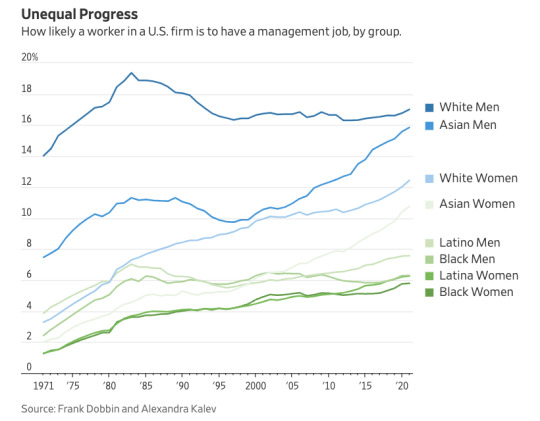
What research shows
The social and behavioral sciences have developed strong evidence about conscious prejudice and implicit bias. Three lines of research, together, are pertinent. One provides good news. As our colleague Larry Bobo has documented, conscious unabashed racial prejudice has fallen consistently since the 1960s. White Americans today largely believe in racial equality.
This isn’t to say that explicit expressions of prejudice have evaporated; in fact they pop up with surprising regularity. The pandemic witnessed precipitous increases in anti-Asian hatred, and according to the Anti-Defamation League, instances of antisemitism are at a record high.
A second line of research shows that less conscious, or implicit, bias has declined more slowly. Bias against some groups has barely budged. If only explicit values and biases drove discrimination, unfair treatment of, say, Black workers would be low. But implicit bias taints employer behavior and decisions. Our colleague Mandy Palais and collaborators find, for instance, that implicit racial bias in grocery-store managers still influences worker performance.
A third line of research uses audit studies, in which matched Black and white people, for instance, apply to the same job. Who gets called in for an interview, or hired? Scores of studies show discrimination by race, ethnicity, gender and disability. These studies show, among other things, that white applicants are about 50% more likely than identical Black applicants to be called back for an interview or offered a job. Other audit studies show discrimination in real-world access to financial resources, healthcare and treatment by the law and law enforcement.
Research by Lincoln Quillian and colleagues compares the results of audit studies over time, finding that discrimination against Black job applicants is virtually unchanged from a generation ago. And the economist Raj Chetty and colleagues not only show a shocking drop in American upward mobility over time, but also show that in regions with high levels of implicit bias, Black Americans are less likely than white Americans to move up the economic ladder.
Research by Lincoln Quillian and colleagues compares the results of audit studies over time, finding that discrimination against Black job applicants is virtually unchanged from a generation ago. And the economist Raj Chetty and colleagues not only show a shocking drop in American upward mobility over time, but also show that in regions with high levels of implicit bias, Black Americans are less likely than white Americans to move up the economic ladder.
Research from one of us, Frank Dobbin (with Alexandra Kalev), meanwhile, shows how likely a worker in a U.S. firm is to have a management job, by group. Women and people of color see increases until the mid-1980s. But progress stalls for Black and Hispanic workers after that. Men from those groups make no progress between then and 2021, and women make almost no progress. We clearly have more work to do to equalize opportunity.
Falling short
It’s not hard to conclude from all these studies that we are not the land of opportunity for everyone we claim to be. An enlightened society should see that education about the prevalence of discrimination is imperative. In fact, it would be downright dumb not to educate people.
But, as Dobbin and Kalev have shown, the typical DEI training doesn’t educate people about bias and may even do harm.
Most training programs fall short on two fronts. First, they use implicit-bias education to shame trainees for holding stereotypes. Trainers play gotcha, sending trainees to take an online test co-developed by one of us, Mahzarin Banaji, for education and research. Instead of training people about research that finds that bias is pervasive, trainers use the test to prove to trainees that they are morally flawed. People leave feeling guilty for holding biases that conflict with American values.
“Gotcha” isn’t going to win people over. The approach is disrespectful, and misses the main takeaway from implicit bias research: Everyone holds biases they don’t control as a consequence of a lifetime of exposure to societal inequality, the media and the arts. Trainers should introduce these ideas with humility, for trainers themselves can’t help but hold these very biases. They could easily educate themselves about the implicit bias research with resources at outsmartingimplicitbias.org.
The second problem with most trainings is that they seek to solve the problem of bias by invoking the law to scare people about the risk of letting bias go unchecked. Trainers recount stories of big companies brought to their heels by discrimination suits. They detail rigid do’s and don’ts for hiring, disciplining and firing people. They require trainees to pass tests on what the law forbids. All of this makes it clear that the CEO approved the training solely to avoid litigation. Trainees leave scared that they will be punished for a simple mistake that may land their company in court.
Trainings with this one-two punch—you are biased and the law will get you—backfire. The research shows that this kind of training leads to reductions in women and people of color in management.
Why would diversity training actually make things worse? Making people feel ashamed can lead them to reject the message. Thus people often leave diversity training feeling angry and with greater animosity toward other groups (“There’s no way I’m biased!”). And threats of punishment, by the law in this case, typically lead to psychological “reactance” whereby people reject the desired behavior (“Nobody’s telling me what I can’t say!”). This kind of training can turn off even supporters of equal-opportunity programs.
A better way
It doesn’t have to be this way, and Dobbin and Kalev’s research on training points to a better alternative. Instead of using legal scare tactics, training programs should give managers a way to counter biases—namely, training in strategies for cultural inclusion. This kind of training teaches skills in listening, observation and intervention. It thus helps managers to hear employee concerns, notice when workers are feeling shunned or dissed, and intervene. It also offers skills for starting tough conversations about how to treat colleagues at work.
Those are skills from Management 101, but managers often don’t want to hear bad news, so they don’t ask employees about troubles, watch teams for signs of bullying, or speak up when they sense a problem. Reminding managers that they can use these tools to suss out problems and nip them in the bud helps them to feel capable of managing biases and microaggressions. When managers use these skills, they retain women and people of color for long enough to come up for promotion. That’s how good diversity training can boost diversity. Unfortunately, only about a quarter of diversity trainings emphasize cultural inclusion.
Moreover, if training succeeds in conveying the findings from bias research—that bias is unseen but pervasive—it can build support for wider systemic changes designed to tear down obstacles to equal opportunity. In that sense, training isn’t designed to blame people for their moral failings. Instead, it’s galvanizing them to support organizational change by arming them with knowledge.
In the end, DEI training can’t squelch implicit bias; nothing short of changing people’s life experiences can do that. But when done right, implicit-bias education can alert students to the fact that people committed to equality nonetheless hold biases. And that knowledge can, in turn, motivate them to reshape their workplaces to counter discrimination by democratizing key parts of the career system.
That means extending recruitment visits from Harvard to Howard; offering mentors to each and every worker; and inviting all employees to nominate themselves for skill and management training programs. It means offering work-life supports to people up and down the ladder. Each of these changes has been shown to produce significant increases in managerial diversity.
The lesson here, the one that should be at the core of DEI training, is that implicit bias resides in individuals, but it resides in organizational career systems as well. And fixing those systems is as simple as democratizing them.
Mahzarin Banaji is a professor of psychology at Harvard University and co-author of “Blindspot: Hidden Biases of Good People.” Frank Dobbin is a professor of sociology at Harvard University and co-author of “Getting to Diversity: What Works and What Doesn’t.” They can be reached at [email protected].
[ Via: https://archive.is/0D4kV ]
==
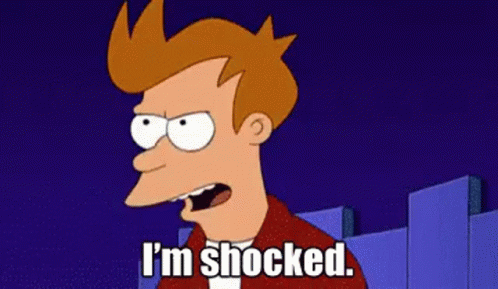
#diversity training#DEI training#implicit bias#implicit association#implicit bias test#implicit association test#diversity equity and inclusion#diversity#equity#inclusion
9 notes
·
View notes
Text
There was/is a study by Joshua Correll that tested how skin color affected a police officer's decision to shoot. In the study, when the threat was white, the cops were so reluctant to shoot that they allowed the threat to harm them or others. When the threat was Black, they were much quicker to shoot. However they were so quick to shoot when the race was Black that they would shoot innocent Black ppl during the test. The study was/is called "Police Officer Dilemma." This "training" in this video is how it happens because we are a deeply deeply racist country.
#racism in policing#racist policing#racist cops#racism#joshua correll#police officer dilemma#racial bias#police shootings#implicit bias#law enforcement#race and policing#racial disparities
3 notes
·
View notes
Text
Inviting Iowa was disrespectful, and the way she said, "...so we'll have them come" was the giveaway. Having the LSU Tigers come to the White House was little more than a perfunctory afterthought in her mind. The important thing was having the white team from Iowa visit. And you cannot convince me that Jill’s comment about “good sportsmanship” wasn’t aimed at Angel Reese. Foul.
#jill biden#angel reese#caitlin clark#implicit racial bias#tiktok#ingrained racism#double standards#implicit bias#liberal racism
23 notes
·
View notes
Text
I think a lot about my sociology 101 professor, a Marxist anarchist and combat veteran who had a three-link chain tattooed on each wrist. On the first day of class, this cishet white man said to us, “These shackles are a reminder: I am sexist, I am racist, I am homophobic.”
He spoke those words in a tense tone, as though voicing his greatest shame and heaviest burden. He proceeded to explain that no matter how much he learns, no matter how much time he dedicates to social justice, he will always have implicit bias to be accountable for, will always be blinded by privilege in one way or another, and has a lifelong duty to remain humble and keep listening to others.
Honestly, everyone has something to learn from that perspective.
#that professor inspired me to major in sociology myself. he dedicates his teaching to radicalizing his students towards the left#in fact I think my entire class walked out the door with a little more empathy and a more open mind to people different from us#I’m incredibly grateful for that#also his rate my prof is half ‘dr. b changed my life and I’ll never forget him’ (me) and ‘this commie is teaching liberal propaganda’ (lmao#for the record he’s very brave for doing that because the college I went to was in Texas#(I promise this is my last political post of the day 👀)#marxism#anarchism#social justice#implicit bias#leftism#sociology#logan.txt#on politics
14 notes
·
View notes
Text
If you think you don't have a bias against me you need to think twice. Think about the things you say to me. The ways you act around me. Your attitude towards me. And then work to deconstruct the ways which you interact with me that aren't kind, helpful or necessary. I would love to be doing the legwork right now but I have a severe trauma disorder and I am in squalor. I need other people to be examining their behavior because I'm doing it every second of every day only to survive another day, not even coming close to living comfortably! Please, I need this from you, not because I think you're shit or cringe or bad or secretly a psychopath or what the fuck ever, it's because I believe you can do better because you're smart, cool and sexy god damn it! So do yourself a favor and grow a relationship with me if you're starting a friendship with me. I need you to water the seed, and I need you to consider what kind of water you're using too. I'm sensitive in general, not just about myself. Meet me where I'm at. I'd do the same for you.
#actually bpd#disabled#chronic pain#autistic adult#chronic illness#sick AF#cannabis patient#legalize it#eds#pots#mals#head injury#suicide survivor#abuse survivor#dbt#anti capitalist love notes#op#implicit bias
2 notes
·
View notes
Text
I have implicit biases and you probably do too! The important thing is I do my best to recognize and work on them. I have an online friend who I chat with on discord. I turned on voice chat and realized they do not have an American accent. I then realized I would probably had thought differently of them if I had heard their voice first. Now I can fix that and go on as a better person. It is better to recognize you are not perfect. I believe it is more virtuous to start out imperfect and have to work to be a better person than start out golden, because working to being better shows you really care. AND DON’T YOU DARE TRY AND SAY YOU DON’T HAVE BIASES WHEN THE PERSON YOU ARE BIASED TOWARDS POINTS IT OUT. Refusing to acknowledge and work on faults is immature and shows you won’t fix it when you hurt people. “But I’m neurodivergent, or gay, or *insert marginalized identity here*” That doesn’t make you immune to bias and propaganda. Just be mature and accept you make mistakes and so you don’t hurt someone next time!!!!
#bias#marginalizedcommunities#propaganda#marginalized groups#marginalization#implicit bias#racisim#ethnocentrism#mistakes#virtue#working on myself
2 notes
·
View notes
Text
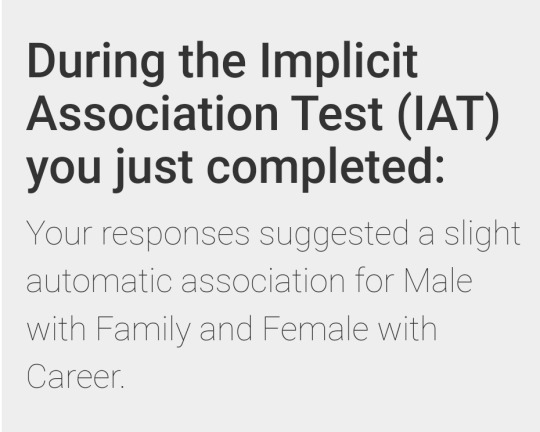
I have a diagnosed girlboss-malewife bias.
2 notes
·
View notes
Text
Not going to say much on what's happening in the OSC, but heavily lambasting people without actually talking to them about what they have done wrong, especially if they admit didn't know much about the context of the issue, is not helpful.
You can at least educate them about it. That's fucking more productive than blasting them on your account. Also, since this is on the topic of racism (and you know who's awful video as well), I feel the need to say this:
If you are white, don't butt in on an issue that harmed BIPOC. Just listen to us, or at least be supportive.
Also, for white allies, you don't need to callout every single other white person for their mistakes. I honestly rather you try to talk to them first to help them understand. I have concerns if you do more calling out over actually having a conversation.
You are not helping if you do this.
If other BIPOC are trying to tell you that you are not helping, listen please.
You don't have to hit people over the head for them to learn. You really don't need to. Just at least, reach out to them. Please.
You can hold people accountable and help them understand what they done wrong at the same time!
With this said, I highly suggest watching this video by
F. D. Signifier on how not to be an ally:
youtube
#osc#aib#WebzForevz#objectshow community#tw racism#just tagging the topic I am not making accusations#but I feel like I need to say something#f. d. signifier#how not to be an ally#aib object show#that one post was giving me white savior complex vibes#I don't condone what the creator aib said as it's still shitty#but you can like talk to them????? this is not the repeat of Taylor Grodin's actions#it feels like it distracts from the main crux of the problem: implicit bias#I do want the aib creator to apologize at some point tho#taking a risk to post this ahhahh don't clown under this post please#Youtube#implicit bias
18 notes
·
View notes
Text
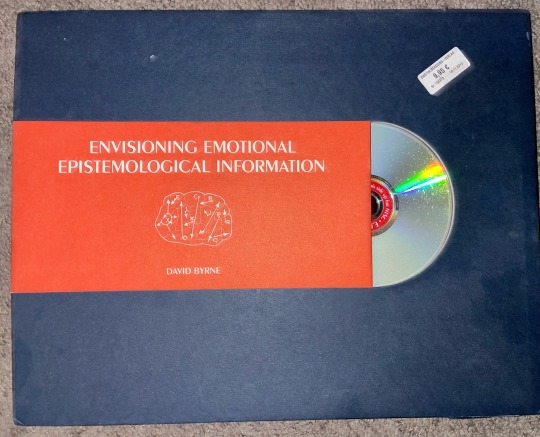
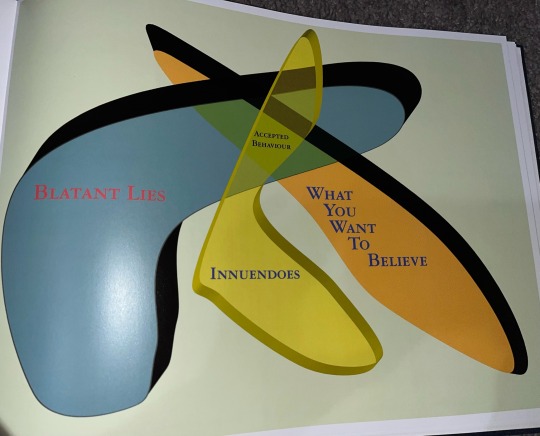


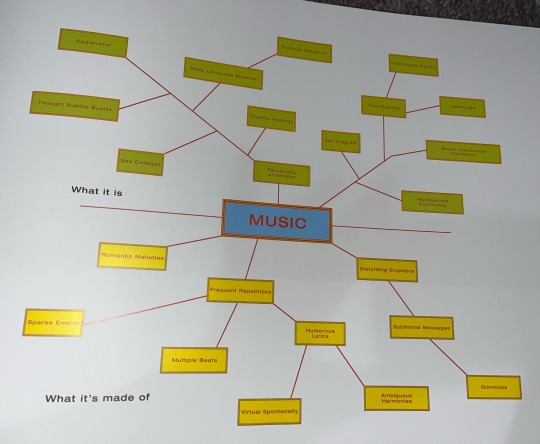




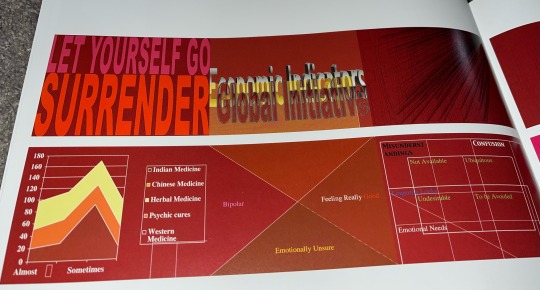

"Like The New York Times, CNN and network news programs, it [PowerPoint] appears to be neutral, unbiased and free of any leanings one way or another. Just as a hammer does not tell you what kind of house to build, Microsoft would like us to think...that their product is merely a neutral tool. It is faceless, and it is what you put into it that counts.
However, every piece of software comes with its own set of biases and tendencies. The most obvious bias and the easiest to see in PowerPoint, is the Auto Content Wizard, a feature that makes outlines of presentations with bullet points for those who feel they don't know how to make a presentation themselves...
However, there are more subtle sets of biases at work. The way the PowerPoint is structured and the various options provided have not only been limited...but they have been designed assuming, a priori, a specific world view. The software, by making certain directions and actions easier and more convenient than others, tells you how to think as it helps you accomplish your task. Not in an obvious way or in an obnoxious way or even in a scheming way. The biases are almost unintentional, they are so natural and well-integrated. It is possible that the engineers and designers have no intention of guiding and straightening out your thinking; they simply feel that the assumptions upon which they base their design decisions are the most natural and practical. You are thus subtly indoctrinated into a manner of being and behaving, assuming and acting, that grows on you as you use the program."
—David Byrne, "Exegesis," Envisioning Emotional Epistemological Information
#david byrne#EEEI#envisioning emotional epistemological information#powerpoint#powerpoint art#art#socialization#soft paternalism#paternalism#implicit bias#philosophy#practical reasoning#philosophy of action#moral psychology#framing effects#starting points#libertarian paternalism#choice architecture#Cass Sunstein#Richard Thaler#paternalism is unavoidable 🤷🏼♀️#this applies to AI too#ai#artificial intelligence#ethics#ethics of AI#bias#algorithmic bias#posting this because the caroline polachek late show performance of “dang” reminded me of this book#my library
35 notes
·
View notes
Text
Woke Babysitter pt 32
#talkin#thisismikeo#woke babysitter#tik tok#ai#artificial intelligence#the algorithm#implicit bias#confirmation bias#racism#racism in tech
42 notes
·
View notes
Video
Google AI
#tiktok#AI#google#internet#technology history#tech news#technology#Implicit bias#bias#science news#science#computer science#computer
38 notes
·
View notes
Text
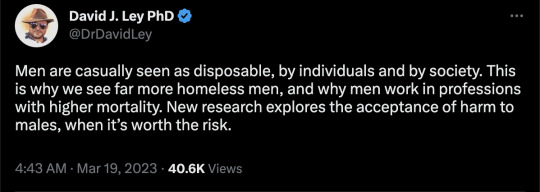

Abstract
Scientific and organizational interventions often involve trade-offs whereby they benefit some but entail costs to others (i.e., instrumental harm; IH). We hypothesized that the gender of the persons incurring those costs would influence intervention endorsement, such that people would more readily support interventions inflicting IH onto men than onto women. We also hypothesized that women would exhibit greater asymmetries in their acceptance of IH to men versus women. Three experimental studies (two pre-registered) tested these hypotheses. Studies 1 and 2 granted support for these predictions using a variety of interventions and contexts. Study 3 tested a possible boundary condition of these asymmetries using contexts in which women have traditionally been expected to sacrifice more than men: caring for infants, children, the elderly, and the ill. Even in these traditionally female contexts, participants still more readily accepted IH to men than women. Findings indicate people (especially women) are less willing to accept instrumental harm befalling women (vs. men). We discuss the theoretical and practical implications and limitations of our findings.
Introduction
The promise of achieving “the greater good” has inspired numerous interventions designed to move society toward presumably desirable ends. Companies develop and market products to improve quality of life, organizations introduce policies to improve employees’ workplace experiences, and educators implement practices to improve learning outcomes. These interventions are frequently justified by claims that the benefits to many outweigh the potential harms to a few—a moral argument consistent with a utilitarian ethical framework.Footnote1
A utilitarian approach to morality accepts inflicting harm onto some people if doing so increases the sum total of human happiness and well-being (e.g., Mill, 1861/2010; Singer, 1981, 2020). Guided by the classic tenets, Kahane et al. (2018) identified two elements that reflect the negative and positive features of utilitarian reasoning. The negative dimension—instrumental harm (colloquially known as collateral damage)—gives a moral agent permission to “instrumentally use, severely harm, or even kill innocent people to promote the greater good” (Kahane et al., 2018, p. 132). Impartial beneficence reflects the positive aspect of utilitarianism, requiring prioritization of the greater good above all else. In its purest form, this element demands people ignore personal ties, family loyalties, group memberships, special preferences, and emotional impulses that compromise impartiality and achieving this greater good (e.g., Hughes, 2017).
However, people frequently depart from such prescriptive moralities (Hughes, 2017; Kern & Chugh, 2009), seldom approaching the level of impartiality required to practice utilitarianism and accept sacrifices that may contribute to the greater good. Indeed, judgments about benefit and harm are highly subjective (Schein & Gray, 2018) and even malleable (Haslam, 2016; Rozin, 1999). This subjectivity, coupled with the difficulty of achieving consensus on what constitutes the greater good, undermines impartial calculi of costs and benefits requisite for upholding utilitarian principles.
The current investigation examined one factor that might compromise the impartial evaluation of social interventions: the gender of the person who experiences instrumental harm (Instrumental Harm). Based on prior research on perceptions of harm to women and men, we hypothesized that people asymmetrically support interventions inflicting collateral harm to men versus women. Such a bias violates the principle of impartial beneficence, potentially compromising the evidence-based advancement of men and women alike. As detailed below, our predictions are rooted in extant work on gender and moral decision-making and are extended to contexts depicting low-level harm.
[...]
General Discussion
The current investigation sought to examine whether people were more willing to endorse interventions when IH was borne by men than women. Our first two studies supported this premise. Importantly, however, our results showed that this asymmetry was driven primarily by women, but not men, being more likely to accept IH to men than to women across a variety of contexts (i.e., supporting Hypothesis 2). Study 3 tested a boundary condition to this gender bias in harm tolerance: stereotypically female caregiving contexts. When instrumental harm benefitted vulnerable individuals (e.g., infants, young children, sick, or the elderly), both men and women exhibited a bias in their willingness to accept IH to men versus women (i.e., supporting Hypothesis 1; not supporting Hypothesis 3). That is, contrary to what might be expected by historical gender roles (Eagly & Wood, 1999), people believed men ought to bear greater costs, even in traditionally female sacrificial domains.
Theoretical and Practical Implications
Our findings offer four contributions. First, we extended the literature on gender and harm endorsement, which has primarily emphasized high-conflict sacrificial dilemmas involving questions of life or death (e.g., FeldmanHall et al., 2016; Skulmowski et al., 2014). The current findings revealed this gender bias persists in highly consequential, yet understudied domains: assessments of beneficial interventions carrying negative externalities across a variety of contexts: medical, psychological, educational, sexual, and caregiving. Second, we demonstrated that when evaluating interventions, female participants were more likely than male participants to accept IH borne by men than women. This pattern lends further support to the well-documented finding that women have a stronger in-group bias than men (e.g., Glick et al., 2004; Rudman & Goodwin, 2004) and are more likely to perceive one another as victims than perpetrators (Reynolds et al., 2020). This disparity suggests women may prioritize one another’s welfare over men’s in the construction or approval of social, educational, medical, and occupational interventions. If so, female policymakers might be especially wary of advancing policies or initiatives risking harm to other women, but less so when they risk harming men.
Third, we tested a boundary condition to this gender bias by investigating contexts previously unstudied in sacrificial dilemmas: stereotypically female caregiving roles. Although consideration of gender stereotypes and role congruence (Eagly & Wood, 1999) might predict a greater tolerance for female sacrifice in such contexts, men and women alike were more tolerant of IH incurred by men (versus women). These patterns suggest that although women traditionally fill and sacrifice in these roles, people may not necessarily endorse that ought to be the case. Rather, our results align with emerging evidence documenting diminished concern for men’s suffering due to a greater tendency to stereotype men as perpetrators rather than victims (Reynolds et al., 2020).
Fourth, our findings identified individual-level factors that contribute to asymmetries in harm tolerance. Namely, Studies 2 and 3 revealed that individuals more strongly endorsing egalitarian, feminist, or liberal ideologies exhibited greater disparities in their acceptance of instrumental harm, such that they more readily tolerated instrumental harm borne by men. These patterns suggest those most concerned about rectify- ing historical injustices might most ardently oppose explora- tory interventions potentially providing long-term benefits to women.
[ Via: http://doi.org/10.1007/s10508-023-02571-0 ]
==
Must be all their male privilege.
#science#male disposability#gender bias#implicit bias#women and children first#the greater good#moral psychology#morality#human psychology#male suicides#male privilege#religion is a mental illness
21 notes
·
View notes
Text
during the civil war, abraham lincoln had a map drawn of each municipality of the south, showing the racial makeup of each one. this was used in strategizing, because whites who lived in districts with more slaves tended to defend the confederacy (and slavery) more vigorously.
today, IAT scores on racial bias are still geographically correlated to the attitudes observed during the civil war. the populations of these municipalities have changed significantly in 160 years, but their attitudes relative to the rest of the South have not.
psychologists hypothesize that this may be because people have a strong tendency to become “of” the place they reside, regardless of where they come from. the place and its community has a stronger influence over people’s attitudes than they may be aware of.
that said, IAT data also shows that racial bias has decreased 25% since 2007, and could reach neutrality within 15 years. as strong of an influence that specific environments can have, the broader culture has an influence over each one, leaving none unaffected.
#i listened to a lecture by a leading scientist who pretty much invented the field of implicit bias. feeling a lot of different things#data also suggests neutrality on homophobia in as soon as 1.5 years. btw#(not all trends are so positive… but at least there’s no sign of attitudes becoming more harmful!)#(additional disclaimer but i believe this specific data is US only. not sure how other countries are doing)#psychology#implicit bias#nat.txt
2 notes
·
View notes
Text
Still so much to work on
Someone made a commented on my last post about me having bpd and demonizing npd. At first I was like, how the hell? Even tried to double down on it. This person is right. I did and I am demonizing npd. I have come to the conclusion that it is my own implicit bias against those who may show narcissistic traits. It comes from a place of great hurt. Even so, it doesn't make it right to do that against another. I acknowledge that I have a real hard time empathizing with those who have hurt me, especially when it has greatly impacted my health and wellbeing. Which is really interesting, because based on my perception, I feel like those with npd also come from a place of hurt. So maybe I'll start there...that they also are doing the best they can with what they have been handed.
I am not going to lie to you. I am human, I judge just like the rest of you. I am no better, but I am also no worse. I have implicit biases, misconceptions, stereotypical associations, and other negative views. And part of my growth is seeing these thoughts and perceptions and doing my best to recognized them, work through them, and change them. I am going to slip up, but I need to be called out when I do and even though it sucks to be criticized, it is needed and overall greatly appreciated.
2 notes
·
View notes